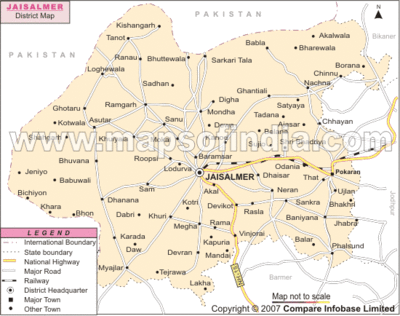Jaisalmer
Jaisalmer (जैसलमेर) is city and district in Rajasthan. Its ancient name was Jaisalmeru (जैसलमेरू).
Contents
Founder
Bhatti Chief Rao Jaisal in 1155 AD
Location
It is located within a rectangle lying between 26°.4’ –28°.23' North parallel and 69°.20'-72°.42' east meridians. It is the largest district of Rajasthan and one of the largest in the country. The breath (East-West) of the district is 270 Kms and the length (North-South) is 186 Kms. On the present map, district Jaisalmer is bounded on the north by Bikaner, on the west & south-west by Indian boarder, on the south by Barmer and Jodhpur, and on the east by Jodhpur and Bikaner Districts. The length of international boarder attached to District Jaisalmer is 471 Kms.
Tahsils in Jaisalmer District
Villages in Jaisalmer tahsil
Abhainagar, Adkiya, Akal, Alam Ka Gaon, Amar Sagar, Arjana, Asayach, Asoda, Asoo Ka Tala, Babuwali, Bachhiya Chhor, Bada, Bada Bag, Badhwa, Badoda-Gaon, Bahla, Balana, Bandha, Baramsar With Baisakhi, Baran, Basanpeer (Jooni), Basanpeer (Southern), Basna, Bersiyala, Bhadasar, Bhagoo Ka Gaon, Bhairwa, Bhiloi, Bhinda Khara, Bhinda Mangaliyowala, Bhiyan, Bhojasar, Bhojka, Bhoo, Bhoon, Bhuwana, Bichau, Bichhiya, Bida, Birma, Boha, Buili, Buranwali, Butoi Jeevanwali, Butoi Rahimwali, Chandhan, Chandoo, Chandrau, Changaniyon Ki Basti, Chaudhariya, Chauhani, Chhatrel, Chundhi, Dabla, Dabri, Damodara, Darbariyon Ka Gaon, Dav, Dedha, Deega, Delasar, Deuga, Dewa, Dhanana, Dhandhiya @ Sadiya, Dhaneli, Dhanwa, Dhauwa, Dhaysar, Dhoba, Dhuliya, Doojasar, Dorau, Drablapar, Edewali, Ekalpar, Gajau, Gamnewala, Ganeshiya, Ganeshiya Kot, Ganga, Geraja, Ghotadoo, Gogade, Gorera, Gunjangarh, Habur, Hada, Hadda, Hakra, Hameera, Hameeron Ki Basti, Hansuwa, Harda, Harnau, Hatar, Hema, Jaisalmer (M), Jaisoorana, Jajiya, Jamra, Jamrau, Janiya, Jaskaranpur, Jawandh Jooni, Jawandh Nai, Jayan, Jerat, Jetha, Jethwai, Jhabra, Jhalariya, Jhanda Khara, Jhanda Madhoojowala, Jhanda Meetha, Jiyai, Jiyau Khara, Jodha, Joga, Joga, Kabeer Basti, Kahla, Kakab, Kalau, Kalyan Ghat, Kandiyala, Kangoor, Kanod Beerma, Kanod Rawlotan, Kanoi, Karam Wala, Karda, Karmon Ki Dhani, Karta, Katha, Kathodi, Kerla, Keshoovon Ki Basti, Khabdela, Khabha, Khaderon Ki Dhani, Khardi, Khariya, Khariya Bhaikhan), Khariya Jethwi, Kheenwsar, Kheenyawas Rarki, Kheeya, Khoohri, Khuifatoojanwali @Khadoojanwali, Khuiyala, Kiradwali, Kishan Ghat, Kishangarh, Kodariya Ka Gaon, Kolootala, Koriya, Kuchhri, Kula Tala, Kuldhar, Kumhar Kotha, Kundhau, Kuntara, Lakha, Lakhmanon Ki Basti, Lalewali, Lambapar, Lanela, Langtala, Lidariwa, Liloi, Lohar, Longewala, Loonar, Loonon Ki Basti, Maghla, Mahwa, Malingda, Mandha, Mandhalwali, Mandhau, Maneri, Mangliyawas, Manpiya, Masooriya, Matwon Ki Basti, Meerwala, Meethatala, Megwalon Ki Dhani, Mehboob Ka Par, Mehna, Mehnau, Mehrana, Mithrau Khara, Mithrau Mochiyonwala, Mohangarh, Mokla, Moklat, Momdau, Moolsagar, Moondri, Motikilon Ki Dhani, Muhar, Mukne Ka Tala, Mungel, Murar, Myajlar, Naga, Nagon Ki Dhani, Nawatala, Neemba, Nehdai, Netsi, Nibiya, Nichoowali, Nijau, Parewar, Patanwali, Peerau, Phaleri, Piparla, Pithala, Pochheena, Pohar, Polji Ki Dehri, Rabhlau Fakironwala, Rabhlau Rajronwala, Raghwa, Rahoon Ka Par, Raimala, Ramgarh, Ramkunda, Ratrau, Ratta, Ratwa, Rehrund, Relna, Ridawa, Rojaniyon Ki Basti, Roopsi, Sadhawala, Sadhna, Sadrau (Pohar), Sagra, Sagron Ki Basti, Salkha, Sam, Sameja Par, Sanger, Sankhla, Sanwala, Sata, Selat, Serawa, Seuwa, Shahgarh, Shahra, Shekhar, Sipala, Siyalon Ki Basti, Siyambar, Soma, Somrau, Sonoo, Sorhakor, Soron Ki Dhani, Sultana, Surron Ki Dhani, Suwar, Tadana, Tanot, Tejpala, Tejsi, Tejwa, Thaiyat, Tharoi, Tibansar, Turkon Ki Basti, Ukralapar,
History
Jaisalmer Fort: Built in 1156 by the Bhati ruler Jaisal, Jaisalmer Fort, situated on Meru Hill and named as Trikoot Garh has been the scene of many battles. Its massive sandstone walls are a tawny lion colour during the day, turning to a magical honey-gold as the sun sets. The famous Indian film director Satyajit Ray wrote a detective novel and later turned it into a film − Sonar Kella (The Golden Fortress) which was based on this fort. About a quarter of city's population still live inside the fort. The main attractions inside the fort are: Raj Mahal (Royal palace), Jain temples and the Laxminath temple.
Jain heritage of Jaisalmer: Jaisalmer has been enriched by its Jain community, which has adorned the city with beautiful temples, notably the temples dedicated to the 16th Tirthankara, Shantinath, and 23rd Tirthankara, Parshvanath.
There are seven Jain temples in total which are situated within the Jaisalmer fort built during the 12th and 15th centuries. Among these temples, the biggest is the Paraswanath Temple; the others are Chandraprabhu temple, Rishabdev temple, Shitalnath Temple, Kunthunath Temple, and Shantinath Temple. Known for their exquisite work of art and architecture that was predominant in the medieval era the temples are built out of yellow sandstone and have intricate engravings on them.
Jaisalmer has some of the oldest libraries of India which contain rarest of the manuscripts and artifacts of Jain tradition. There are many pilgrimage centres around Jaisalmer such as Lodhruva (Lodarva), Amarsagar, Brahmsar and Pokharan.
जैसलमर
विजयेन्द्र कुमार माथुर[1] ने लेख किया है ...जैसलमर (AS, p.370) राजस्थान की प्राचीन रियासत तथा उसका मुख्य नगर है. किवदंती के अनुसार जैसलराव ने जैसलमेर की नींव 1155 ई. (1212 विक्रम संवत) में डाली थी. कहा जाता है कि जैसलराव के पूर्व-पुरुषों ने ही गजनी बसाई थी और उन्होंने ही राजा शालिवाहन के समय में सियालकोट बसाया था. किसी समय जैसलमेर बड़ा नगर था जो अब इसके अनेक रिक्त भवनों को देखने से सूचित होता है. प्राचीन काल में यहां पीला मुलायम संगमरमर तथा अन्य कई प्रकार के पत्थर तथा मिट्टियां पाई जाती थी जिनका अच्छा व्यापार था. यह सारा नगर ही पीले सुंदर पत्थर का बना हुआ है जो नगर की विशेषता है. यहां के मंदिर प्राचीन भवन और प्रासाद भी इसी पीले पत्थर के बने हुए हैं और उन पर जाली का बारीक काम किया हुआ है. जैसलमेर के प्राचीन ऐतिहासिक स्मारकों में सर्वप्रमुख यहां का किला है. यह 1155 ई. में निर्मित हुआ था. यह स्थापत्य का सुंदर नमूना है. इसमें बारह सौ घर हैं. 15 वीं शती में निर्मित जैन मंदिरों के तोरणों, स्तंभों, प्रवेश द्वारों आदि पर जो बारीक नक्काशी व शिल्प प्रदर्शित है उसे देखकर दांतो तले उंगली दबानी पड़ती है. कहा जाता है कि जावा,बाली आदि प्राचीन हिंदू व बौद्ध उपनिवेशों के स्मारकों में जो भारतीय वास्तु व मूर्ति-कला प्रदर्शित है उससे जैसलमेर के जैन मंदिरों की कला का अनोखा सामय है. किले में लक्ष्मीनाथ जी का मंदिर अपने भविष्य के लिए प्रख्यात है. नगर से चार मील दूर अमरसागर के मंदिर में मकराना के संगमरमर की बनी हुई मनोहर जालिया निर्मित हैं. जैसलमेर की पुरानी राजधानी लोद्रवापुर थी. यहां पुराने खण्डहरों [p.371]: के बीच केवल एक प्राचीन जैन मंदिर ही है जो काल-कवलित होने से बचा है. एक प्राय: एक सहस्त्र वर्ष प्राचीन है. जैसलमेर के शासक महारावल कहलाते थे.
Jaisal founded Jaisalmer
Jaisalmer was founded by Bhatti Chief Jaisal . Earlier the capital of Bhatts was at Lodorva ruled by nephew of Jaisal named Bhojdeo. Bhojdeo had not long occupied the gadi of Lodorva, when his uncle Jaisal conspired against him ; but being always surrounded by a guard of five hundred Solanki Rajputs, hiss person was unassailable. At this time, the prince of Puttun was often engaged with the king s troops from Tatha. Jesul, in pursuance of his plan, determined to coalesce with the king, and cause an attack on Puttun (Anhulwarra), by which alone he could hope for the departure of the Solanki body-guard. Jaisal, with his chief kin, escorted by two hundred horse, marched to the Punjnud, where he saw the king of Ghor, who had just overcome the king of Tatha, and placed his own garrison there, and he accompanied him to Arore, the ancient capital of Sind. There he unfolded his views, and having sworn allegiance to the king, he obtained a force to dispossess his nephew of his territory. Lodorva was encompassed, and Bhojdeo slain in its defence. In two days the inhabitants were to carry off their effects, and on the third the troops of Ghor were permitted the license of plunder. Lodorva was sacked, and Kureem Khan departed for Bekher with the spoils. [2]
Jaisal thus obtained the gadi of Lodorva ; but it being open to invasion, he sought a spot better adapted for defence, and he found one only five coss (ten miles) from Lodorva. Upon the summit of a rocky ridge, he discovered a Brahmin, whose solitary hermitage adjoined the fountain of Brimsir. [3]
On Rubwar, 'the day of the sun,' (a favourite day for commencing any grand undertaking with all these tribes), the 12th of Sravan, the enlightened half of the moon, S. 1212 (A.D. 1156), the foundation of Jessulmer was laid, and soon the inhabitants, with all that was valuable, abandoned Lodorva, and began to erect new habitations. [4]
Jaisal had two sons, Kailan and Salivahan II. He chose his chief ministers and advisers from the children of Sodil, of the Pahoo tribe, who became too powerful. Their old enemies, the Channa Rajpoots, again invaded the lands of Khadal ; but they suffered for their audacity. Jaisal survived this event five years, when he died, and was succeeded by his youngest son, Salivanan II.[5]
Migration of Yadus
James Tod[6] writes that the tide of Yadu migration during the lapse of thirty centuries, traces them, from Indraprastha, Surapura, Mathura, Prayaga, Dwarica, Jadu Ka Dang (the mountains of Jud), Behera, Ghazni in Zabulistan ; and again refluent into India, at Salivahanpura or Salpura in the Punjab. Tannot, Derawal, Lodorva in the desert, and finally Jaisalmer, founded in S. 1212, or A.D. 1156.
Jat Officers Meet
On 15.09.2023 there was a get together to welcome Shailesh Machra IFS 2022 in Jaisalmer Military Station. Following were present: from left to right in picture:
- Shailesh Machra, IFS
- Vikas Sangwan, IPS, SP Jaisalmer
- Col Rajesh Suhag
- Col Beniwal
- Dinesh Kumar
- Col Dharmendra
- Col Nitin Tewatia
- Wing Cdr Lathar
External links
References
- ↑ Aitihasik Sthanavali by Vijayendra Kumar Mathur, p.
- ↑ James Tod: Annals and Antiquities of Rajasthan, Volume II, Annals of Jaisalmer, p.219
- ↑ James Tod: Annals and Antiquities of Rajasthan, Volume II, Annals of Jaisalmer, p.219
- ↑ James Tod: Annals and Antiquities of Rajasthan, Volume II, Annals of Jaisalmer, p.220
- ↑ James Tod: Annals and Antiquities of Rajasthan, Volume II, Annals of Jaisalmer, p.220
- ↑ James Tod: Annals and Antiquities of Rajasthan, Volume II, Annals of Jaisalmer, p.194-195
Back to Rajasthan

